In this article, we will consider the methods and methods of whitewashing trees at different times of the year.
Content
- What trees whiten in spring and autumn, and why do you need whitewashing?
- At what age do fruit trees should be whitened?
- When is it better to whiten fruit trees, apple trees: in autumn or spring?
- When and what to whiten the trees in the spring in Russia, in the Urals, in the suburbs, the middle lane, Belarus: terms, air temperature
- When and what to whiten the trees in the fall: terms, air temperature
- Preparation of trees for whitewashing: description of work
- Three components of the component for whitewash: Names
- How to extinguish and breed lime for whitewashing trees: proportions
- Lime Pushonka - how to breed for whitewashing trees: Recipe
- Preparation of whitewashing for fruit trees with water -based paint: composition, recipe
- Preparation of whitewashing for fruit trees with water-dispersion paint: composition, recipe
- Preparation of whitewashing for fruit trees with copper sulfate: composition, recipe
- Preparation of whitewashing for fruit trees with a bracket of flour: composition, recipe
- Preparation of whitewashing for fruit trees with PVA glue: composition, recipe
- Preparation of whitewashing for fruit trees with chalk: composition, recipe
- Than to whiten the trees so that the whitewash does not wash off: the best recipe
- How to whiten the trunks of young fruit trees?
- Is it possible to whiten the trunks with cherries with lime?
- Is it possible and necessary to whiten trees in the summer, autumn?
- What brush to whiten the trunks of trees?
- Why don't trees whiten in Europe?
- Video: What is the best way to whiten trees?
In the spring, whitewashed trees begin to show off, as well as pillars and borders. And not only in the parks and squares of the city, but also in private houses and large gardens. In our country, subbotniks and white whitewashing have already become a long tradition. But such snow -white beauty is needed not only for aesthetic species. In the right recipe and at the right time, trees are needed to protect and for the purpose of prevention.
What trees whiten in spring and autumn, and why do you need whitewashing?
The lower part of the tree from the root and to the first branch is called the stamp. And it is the most sensitive and vulnerable part of the tree. Therefore, the stem is whiten at least twice a year to protect the lower section.
Why do you need a whitewash for trees:
- In the spring, when the bark is still too thin and did not have time to get stronger to resist the sun, whitewashing will help create a protective layer. But the sun is already starting to heat well during the day.
- But nights are not just cold, but with frosts. The warm rays of the sun heat up the bark of the tree, but the trunk remains still frozen. And at night the bark freezes again, thereby provoking its exfoliation.
- Whitewash plays an important role in reflection of sunlight. The color of the bark is brown, and dark colors attract sunlight. White stamps reflect the light and prevent the bark with heated.
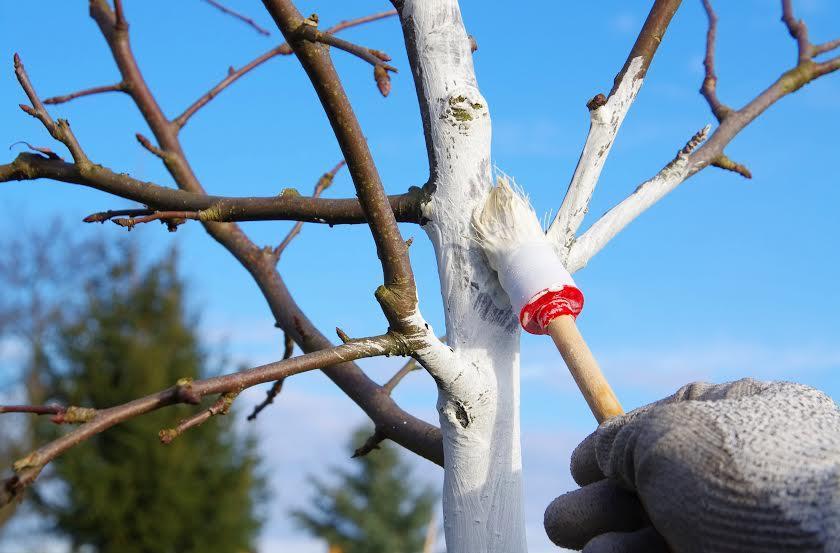
- Also too sharp temperature changes and the scorching sun can cause during the day cracks and drying out. White whitewashing will protect against overheating and will be prevented from cracking the bark.
- The previous reason stems smoothly into the next factor - fungi and infections. And the sore tree is much harder to cure than to conduct a “white” prevention.
- Rodents They also like to enjoy the bark of some trees. And harmful insects They like to put down the larvae in it. The whitewash acts not only with a protective layer, but as an antiseptic.
- In autumn, whitewashing will also protect the stems from temperature changes and prevent the formation of ice crust. Especially in those places where there are cracks or damage to the barrel, because the risk of formation increases morozoboin. And they will further lead to damage to wood.
Important! You need to whiten the trees. Regardless of the variety or age. Some gardeners are convinced that young trees cannot be whitened. This opinion is erroneous, because the main thing in the “protective layer” is a white saturation. Just for young seedlings, lime whitewash should be replaced with a more sparing water -based or chalk paint.
At what age do fruit trees should be whitened?
The bark of young trees is very thin and vulnerable. Therefore, many make a mistake and do not whiten young seedlings until the bark is smooth on them. Do not forget that they are also subjected to sunburn and frostobines, and injury will be serious for them.
- That's why, you need to whiten young trees in the first year of landing!
- If you use lime whitewashing, then its concentration should be minimal. And ideally, take chalk and clay or water -based paint as a basis.
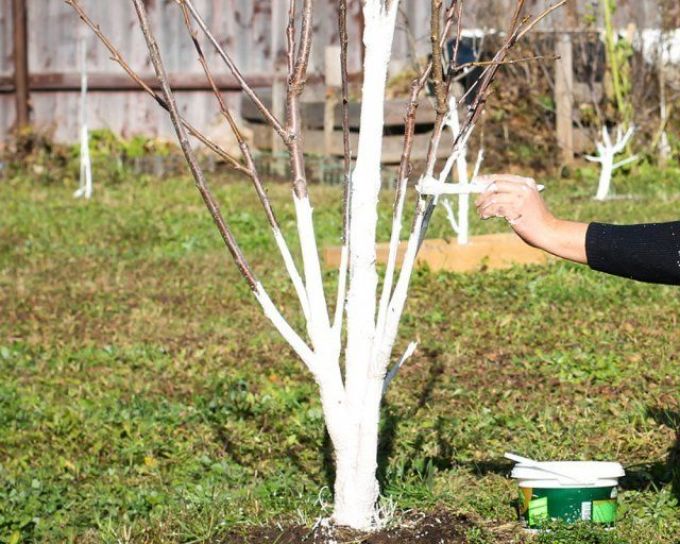
- The whitewash layer should not be too thick. After all, seedlings need to be protected, but not isolated from the outside world.
- You need to whiten not just 20 cm of the stem, then there will be practically no positive effect. It is necessary to capture the entire barrel from the ground and to the plexus of branches, capturing the first row.
- If the spring turned out to be early, then the young trees (and adults too) are needed after the first warm rays of the sun.
When is it better to whiten fruit trees, apple trees: in autumn or spring?
We are used to bringing beauty in the spring, after the first warm days. In the so -called Lenin Subbotnik. But the greatest effect gives Auttermaking apple trees And all fruit trees. Indeed, during this period the largest temperature changes. In the afternoon, it can reach +10-12 ° C, and at night falls to -5-10 ° C. She will also protect the trunks from frost -brushes and help to resist severe frosts and winds.
When and what to whiten the trees in the spring in Russia, in the Urals, in the suburbs, the middle lane, Belarus: terms, air temperature
You need to whiten trees at least twice a year. If this is required by weather conditions or washing the whitewashing, and maybe the crops of trees are very vulnerable, then it is necessary to carry out prevention three times a year:
- Autumn whitewash carried out in late October or early November. It is advisable to carry out such a procedure before frost. And most importantly, the leaves should completely fall. The air temperature should be not lower than +4 ° C so that the whitening solution does not take an ice crust.
- Spring It is necessary to proceed to whitewashing at the end of March - at the beginning of April. The optimum temperature should be +10-11 ° C. It is then that the sapotage begins in the trees. Previously, it is not recommended to whiten trees, since tissue rupture can occur. But the main thing is that it is necessary to whiten trees until the kidneys are formed or at the very initial stage.
- The third whitewash is carried out summer. It does not act mandatory, but there will be no superfluous either. Especially if the whitewashing was washed off with rains or cracked. The temperature regime can be any, but you should not whiten trees at a temperature of +30-35 ° C. Try to choose a non -fire day, without rains. Otherwise, all works will be a drain. It is advisable to conduct it in June.

The solution can be taken not only on the basis of lime. Below are detailed recipes for possible options. But you can also add soap to the main composition (it helps to fight diseases and acts as a kind of antiseptic), PVA or milk glue. The main thing is that the solution sticks well to the bark, but is not too thick. After all, the tree should also breathe.
When and what to whiten the trees in the fall: terms, air temperature
In the fall, whitewashing is carried out until the first frosts. On average, this procedure is carried out in October - November. But if autumn has come early, then you can protect the trees at the end of September. Until the rainy season has come! After all, whitewashing should have time to dry. The deadline should be at a temperature of +3-4 ° C. It is recommended to whiten the trees after falling out of the whole foliage. Use lime, chalk or copper sulfate for this.
Important! From frost, whitewashing cracks and crumbles. Therefore, carry out the procedure before lowering the temperature below -10 ° C.
Preparation of trees for whitewashing: description of work
You need to whitewash the prepared tree, since the quality and resistance of the procedure will directly depend on this.
Important! Cleaning of trees bark should be carried out in raw weather. This will allow you to do a minimum of harm to the upper layer.
- Lichens, moss, mud and dust often appear on the trees. This is all worsening the resistance of whitewashing. Therefore, you need to carefully, but carefully remove everything unnecessary. A soft foam sponge or a fabric glove is perfect.
- If the tree is old or there are many large lichens or mushrooms on it, then use a spatula or a metal brush. But make sure not to damage living fabrics under the bark.
Important! For such a procedure, it is necessary to cover polyethylene around the barrel so that all the pieces do not fall to the ground. After all, they can have fungi and insect larvae. After completing the work, all the garbage must be burned!
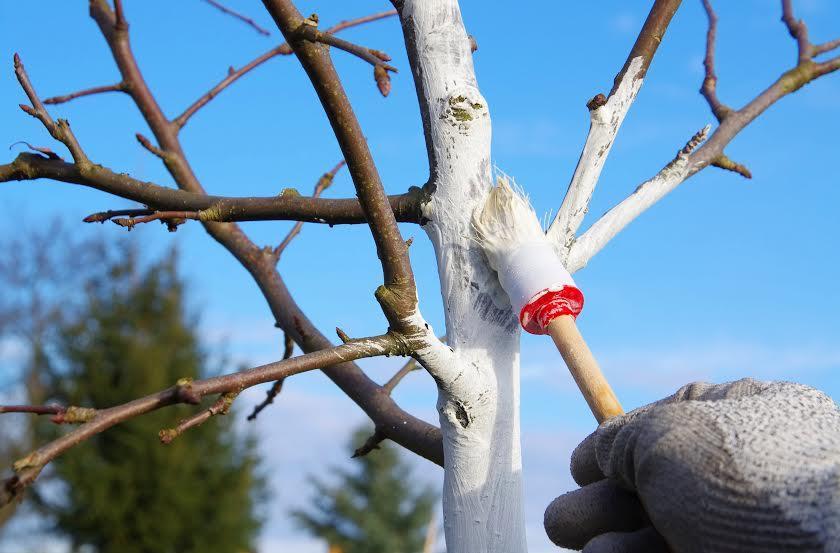
- Now the tree must be disinfected. And after cleaning, the upper layers open, small cracks may also appear. Most often used:
- laundry soap. It is necessary to grate the beam of soap and dissolve in warm water. But wait for its cooling, because sharp changes in the temperature of warm water and cold air only injure a thin layer of wood;
- ash. The ash must be poured on ¼ buckets, pour water and boil. Leave for a day for upholding. Do not mix the liquid! It is necessary to gently drain the upper layer of water, which is located above the sediment. It is she who will be required for processing.
- copper sulfate. It is necessary to take no more than 100 g of powder per 10 liters of water. But such a solution cannot be constantly used! Such a solution accumulates in the bark of the tree, thereby poisoning it. And if this is a fruit tree, then fruits are harmful to the human body on your table.
- Now you need to start processing wounds and large cracks. For this, gardeners use any disinfecting garden pasta or putty. Garden Var, which can be cooked independently, also helps.
- The main component is wood resin, which occupies the main part of the mixture (800 g). Fat or bee wax (not more than 50-100 g) is also added. You can also use pigs. Add another 50-80 g of ash and alcohol.
Three components of the component for whitewash: Names
Of course, you can buy a ready -made garden mixture for whitewashing and it will have all the necessary components. But to cook it yourself will not be difficult, and the ingredients will be found in every home.
Three basic components:
- Lime or chalk is the binding components;
- Soap, clay or PVA glue are adhesive components. It is they who help to better pester the bark. You can also use mullein or milk;
- Ash or copper sulfate - for disinfection. The last component is more effective, but it is constantly undesirable to use it. Conductive soap also belongs to this category.
How to extinguish and breed lime for whitewashing trees: proportions
Unexpected lime is widely used in the construction sector, but only a bastard substance can be whitened. There are three ways, as a result of which lime different in consistency comes out.
Important! Division of lime is accompanied by a violent reaction. The mixture boils, boils, sprinkles and heats up. The temperature can sometimes reach 150 ° C. Therefore, the container needs to be taken high, and work exclusively in gloves and goggles.
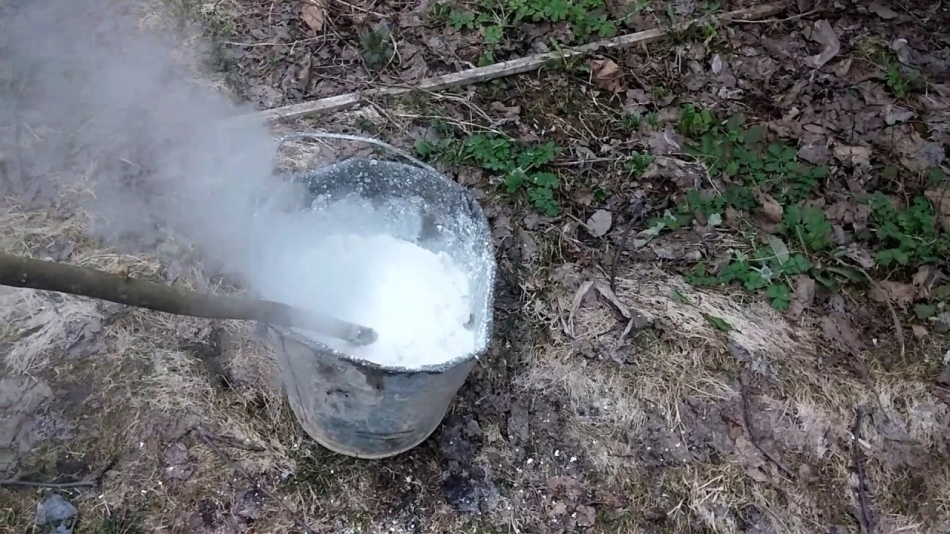
There are three options for a lime mixture:
- pushonka. To obtain it, it is necessary to take the ratio of negative lime and water 1: 1
- lime dough. To prepare it for 1 part lime, you need to take 1.5 parts of water
- lime milk. It has a ratio of 1: 3. That is, you need to take three parts of water per part
Lime is poured with cold water in the desired combination. After passing the reaction, the mixture is carefully and thoroughly mixed. Just do not do this operation with your hands. Even in gloves. Use a stick or a wooden shoulder blade.
Lime Pushonka - how to breed for whitewashing trees: Recipe
This version of the mixture was very fond of gardeners, since it completely covers the trees, creating a fairly thick layer. But at the same time it has a good adhesive ability. It is suitable for all types of trees.
- It is necessary to pour into a bucket in a bucket of lime (2 kg) and pour 2 liters of water.
- Wait, the reaction of hissing will pass the code. Then mix the mixture thoroughly until a homogeneous mass is obtained.
- But this is not yet a finished solution. After all, the lime is simply rummaged very quickly after the first rain.
- Therefore, for 2.5 kg of fur, you must add:
- 9 liters of water;
- 3-4 tbsp. l flour braister;
- it can be seen 10 tbsp. l soap chips or 1 kg of clay, 1 kg of mullein is also suitable.
Important! Lime must be extinguished 2 hours before whitewashing! During this time, lime will “burn out” and will not cause burns to the trees. But, at the same time, it will be very effective in the fight against lichens, mushrooms and pests.
- As a result, lime milk with an adhesive property should be obtained. By consistency, the mixture should be similar to sour cream.
- Keep in mind that too liquid solution will simply drain from the trees. And if it is too thick, it will poorly stick to the bark or crack quickly.
- You can also add 200 g of copper sulfate or 300-400 g of asept as an antiseptic.
Preparation of whitewashing for fruit trees with water -based paint: composition, recipe
Water emulsion paint is already sold in finished form, so it can be safely applied to the stamps of trees. Her undoubted plus is the brightness of color and resistance of paint. White trunks of trees will delight the eye for a very long time, even after the rainy season. But experienced gardeners recommend that it improve it a little.

- In order for the paint to hold better, it needs to be diluted a little. On average, 1 liter of paint is required 5-10 liters of water. Such a large gap, since the solution should not turn out to be too thick or liquid.
- To protect against insects and rodents, it is necessary to add 5% or 10% solution of copper sulfate. Since the paint itself is able to protect the bark only from frost.
Important! The paint must have the inscription "for garden work". Other building options are contraindicated for whitewashing trees.
Preparation of whitewashing for fruit trees with water-dispersion paint: composition, recipe
Water-dispersed paint should also have a “garden” sign. Such a solution received many positive reviews. And the main advantage is the opportunity to breathe trees.
- It includes antiseptic substances. Therefore, the bark will not bite hares, and insects will not postpone larvae.
- It lasts about a year on young seedlings, on adult trees it can stand for about two years. This merit of latex, which is part.
- And the white pigment allows you to achieve beautiful white color.
- Well, the main component is acrylic. It helps to protect trees from sunlight and resist the rains.
- Therefore, such a solution does not require additional components. The only thing that can be added is water. To obtain a more liquid consistency.
Important! Work with a water -based solution at a temperature of 3 to 7 ° C.
Preparation of whitewashing for fruit trees with copper sulfate: composition, recipe
Copper coupor, the main thing needs to be correctly diluted. For this, blue powder is diluted until completely dissolved and only then mixed with previously extinguished lime.
- 2 kg of lime
- 200 g of copper sulfate
- 10 liters of water
- 1 kg of clay
- 0.5 kg of mullein

- The components can be mixed in an arbitrary sequence.
- But, preferably, to first dilute the gamut lime in water, and then pour it into copper sulfate and then introduce clay and mullein in parts.
- The solution must be well stirred so that there are no lumps.
Preparation of whitewashing for fruit trees with a bracket of flour: composition, recipe
This recipe can be supplemented with additional components. The main condition is to prepare a fabric.
Necessary components:
- flour - 250 g
- water - 1 liter
- Water must be taken warm, but not too hot. Pour it into the flour and mix thoroughly.
- Put on fire and, with constant stirring, bring to a boil.
Important! You can not move away from cooking glue. Since he can thicken quickly and strongly, and there is the possibility of forming lumps.
- You need to use glue immediately after cooking. In the future, it becomes thicker and loses its adhesive ability.
How to prepare whitewashing:
- gashenic lime - 2 kg
- manure - 1 kg
- clester from flour-0.8-1 kg
- water - 10 l
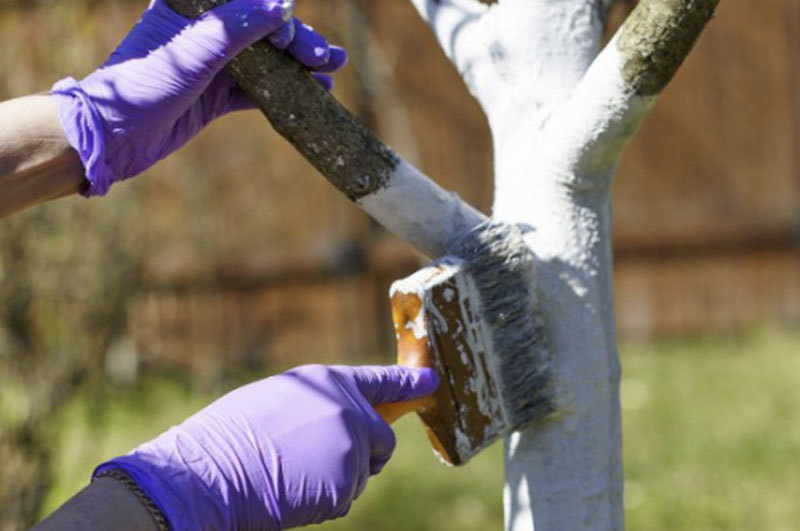
- You need to mix all the components until a homogeneous mixture
- Pour water in parts, bringing the solution to the consistency of sour cream
- Flour allows whitewashing to stick to the bark of the tree and is not washed off with rains
Preparation of whitewashing for fruit trees with PVA glue: composition, recipe
Such whitewashing covers the trunk of a tree like a protective film. This solution is persistent against rains, but the trees do not breathe so well. Therefore, this whitewash is better not to use for young seedlings. And it is best to whiten this tool in the fall, when the stems need to be protected from strong gusts of wind and fierce frosts.
For 5 liters of water, you need:
- 2 kg of bastard lime
- 350 g of copper sulfate
- 1 kg of clay
- 1 kg of manure
- 50-100 g of glue

- First, it is worth diluting copper sulfate with hot water. Then cool.
- Dilute the glue in the bucket of water.
- When it completely disperses, add lime and copper sulfate.
- At the end add manure and clay.
- Mix thoroughly until a homogeneous consistency.
Preparation of whitewashing for fruit trees with chalk: composition, recipe
This recipe allows not only the bark to breathe, but also nourishes it. Mel is absolutely harmless. True, it can greatly overdry the skin of the hands, so you need to work with such a solution in gloves.
- Chalk - 2, 5 kg
- Water - 10 l
- Fatty clay - 1 kg
- Mix chalk with clay. And gradually introduce water, bringing the solution to a state of low -fat sour cream.
- This whitewashing must be whitened twice. But the first layer should dry well. Therefore, in warm and sunny weather, the second procedure is carried out after 2-3 hours.
Than to whiten the trees so that the whitewash does not wash off: the best recipe
An excellent option would be a whitewash based on glue. What substances are added to the stickiness of the product, above were indicated. But the most powerful is casein glue. It can be bought in finished form, or you can cook it yourself. Immediately note that the process is simple, but takes a lot of time.
- Take 1 liter of low -fat milk and put in a warm place until sour. As a rule, one night is enough if the temperature is tolerably high.
- Now you need to filter the liquid through paper or tissue. You can do a faster method - to pour sour milk into a colander. But he should have very small holes or lay down two layers of gauze from below.
- The mass that remained in a jar or glass in a colander must be washed 2-3 times under cold water.
- Then transfer to a fabric bag. And place it in boiling water. You need to cook until it boils all the fat.
- Now it remains to shift the cooked mass to a wooden surface and leave to dry.
Important! Do not use heaters! The glue should dry naturally. Otherwise, he will dry out and lose his adhesive abilities.
- In conclusion, you need to add a little water to get the consistency of sour cream, and 1 tsp of the drill. Glue is ready!

A solution with casein glue:
- 2 kg of lime
- 400 g of copper sulfate
- 100 g of casein glue
- 10 liters of water
- Dilute copper sulfate in hot water. If lime is negative, then you need to repay it. Combine all the components, mix thoroughly so that the mass becomes homogeneous.
- Pour water in parts to get a density of sour cream. Before use, you need to insist 1 hour. With such whitewashing, trees will stand almost the entire season. And its main advantage is security. All components are of natural origin and do not harm trees.
Important! If you want to make such a whitewash even more environmentally friendly, add ordinary ash instead of copper sulfate. Do not forget that it is often carried away by copper sulfate! Therefore, alternate the components with each other. The drill, by the way, also has antiseptic agents and is absolutely harmless.
How to whiten the trunks of young fruit trees?
Young seedlings can and should be whitened! Frosobines and sunburns will cause much more harm than whitewashing. You can use all those components as for adult trees.
Some recommendations:
- The amount of lime must be reduced by half. Or use lime milk, which is bred in a ratio of 1: 4. In this consistency, lime is also suitable for young seedlings.
- Do not use acrylic paint! Because of it, the bark does not breathe, but for young seedlings this is important. Otherwise, the tree will simply die.
- Do not add to PVAbecause he also clogs pores.
- Copper coupor is added 2-3 times less or replace harmless folk remedies.

The safest option for young seedlings:
- 2 kg of chalk
- 200 g of clay
- 100 ml of milk
- 100 g of mullein
- 8 liters of water
- Mix all components until a homogeneous state and dilute with water until a thick sour cream is concentrated.
- It is important that the color of the whitewashing is crystal white. It is then that there will be the maximum protection.
Is it possible to whiten the trunks with cherries with lime?
Another Dean myth that is worth dispelled. All the bone - plums, cherries, cherries and other crops of trees must be squealed! You can use water-based or water-dispersed paint, but lime gives the trees another important component-this is calcium. And it is necessary for the growth of bones. That's why, lime can and should be whitish cherries. Moreover, gardeners are recommended once a month to water seedlings with its weak solution.
Is it possible and necessary to whiten trees in the summer, autumn?
We repeat once again that the autumn whitewash is the most important! Although we are used to bringing beauty in the garden in the spring. To protect trees from frosts, temperature changes in the fall and spring (after all, in February we are not still running with a brush and whitewashing to the garden), from winter hares and other rodents, as well as from wintering of various pests.
- In the summer you can whiten, but you cannot call the procedure mandatory. If you miss the summer whitewashing, then nothing will happen to the trees. But take into account your climate and weather conditions in the summer.
- In the summer, whitewashing acts as a prevention if the spring layer was washed off with rains or cracked and crumbled. Therefore, see the condition of your trees. If the whitewashing does not delight until October, then the trees should be whitewashed in the summer.
What brush to whiten the trunks of trees?
You can whiten trees with any brush that is convenient for you. One rule - do not take too large sizes. They will not speed up the process, but only spray everything around.
- The most convenient painting brushes made of artificial material, or flute brushes.
- Some use rollers, but they will skip irregularities and cracks.
- You can use special sprayers. Such a tool is perfect for large areas.
- The most convenient is McFovitsa. It captures a large part of the bark in one movement. At the same time, the equally well paints both the smooth surface and with cracks.
Why don't trees whiten in Europe?
The first thing to note is a tradition that takes its roots since the time of the USSR. Subbotniks were and remained only with us.
- But the most important reason is hidden in different climate. In Europe, it is softer, and they do not have such temperature jumps. And in some countries, for example, Great Britain or even Poland, due to increased humidity, whitewashing trees becomes simply useless.
- Yes, and which peoples still have such a harsh winter as in Russia.
- Each country of seedlings of seedlings are also different. And they are completely suitable for their climate.
- Do not whitewash, which means that the trees are protected in another way. For example, with the same copper sulfate, garden bandage or synthetic winterizer. The last inventory helps to fight rodents and ants.







